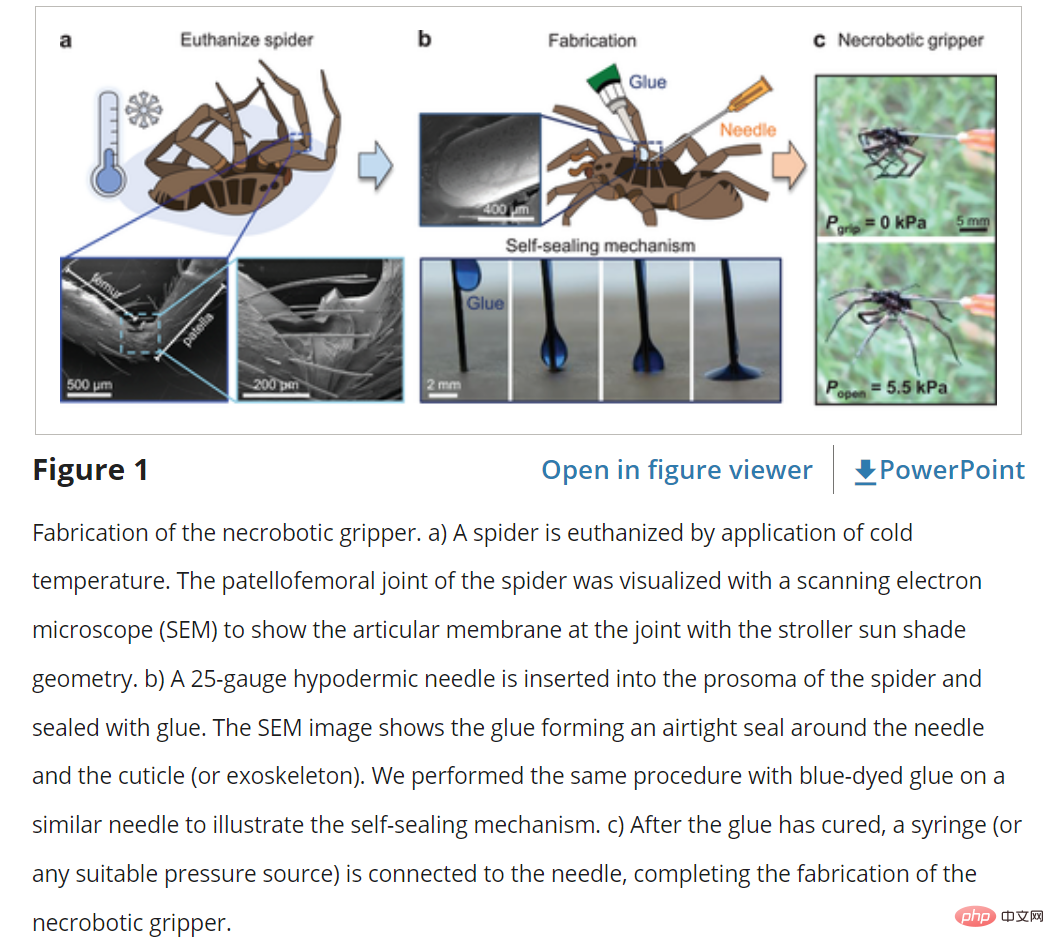
Nature has brought a lot of inspiration to robot research and development, and bionic robots emerge in endlessly. But have you ever seen a robot that uses real animal bodies as components?
As shown below, a dead spider is being used as a mechanical gripper to pick up objects heavier than itself:

This is a study from Rice University in the United States. The paper was published in Advanced Science:

Paper address: https://onlinelibrary.wiley.com/doi/full/10.1002/advs.202201174
We know that spiders’ load-bearing capacity is very Powerful, they can carry objects larger than their own weight. But it is extremely difficult for people to create a robot with similar functions. The Rice study takes direct advantage of the spiders themselves.
Living spiders control their limbs by adjusting blood pressure. Higher pressure will cause the limbs to stretch. When the blood pressure in the body decreases, the limbs will expand due to the lack of blood pressure to balance the strength of the flexor muscles. Curl, curl up.
Researchers believe that this principle can be used to drive the limbs of a dead spider. They inserted an injection needle into the spider's body and injected some air into it. All the spider's legs would expand and straighten, thereby controlling the limbs of the dead spider to expand and contract:

Let’s see what this “spider gripper” can do, grab another spider:

manipulationcircuitboard:

In this work, the researchers used the complete bodies of inanimate creatures (dead spiders, wolf spiders) as living things drive (Figure 1), which the researchers say is the first step towards the field of necrobotics research. The study's strategy differs from biomimetic approaches, in which researchers look to the spider's physical form for design ideas that are then implemented in complex engineered systems. This research also differs from biohybrid systems in that it does not require living or active biological materials as a base and therefore does not require elaborate maintenance.
The research uses spider carcasses to create a pneumatically driven gripper that is fully functional in a simple assembly step, circumventing the tedious steps of making fluid-driven devices.
For example, PneuNet grippers typically require 3D printed molds, multiple different components that need to be cast and assembled, and elastomers that take hours or days to cure, which is cumbersome. The pneumatic gripper realized in this study using spider corpses can lift objects 1.3 times its own weight, generate a peak clamping force of 0.35 mN, and can withstand about 700 actuation cycles.

The researchers' process for making a spider gripper is roughly as follows: insert a needle into the anterior body area of the spider corpse, and use glue to fix the needle to the spider's body. body to form a seal (Fig. 1b). From inserting the needle to setting the glue to create a fully operable gripper, it's done in about ten minutes.
The spider extends each leg by actively contracting muscles in the front body to increase its internal hydraulic pressure. In the case of the spider gripper, an external pneumatic pressure source replaces the inherent regulation in the spider, actuating the limbs as the pressure within the spider increases above atmospheric pressure (Fig. 1c). Pressurization and depressurization, respectively, cause all of the spider's legs to open and close simultaneously, effectively acting as grippers.
The following figure shows the force and displacement representation of the spider's gripper:

Faye Yap, one of the authors of the paper, said that the inspiration for this research came from observations in life: "One day when we were moving things in the laboratory, we noticed that there was something on the edge of the corridor. We are curious about why spiders curl up after death."

# #Faye Yap
They searched the encyclopedia and found the answer: spiders do not have antagonistic muscle pairs (like human biceps and triceps), they Only flexor muscles allow their legs to bend and extend outward via hydraulic pressure. After they die, they lose the ability to actively pressurize their bodies, so they curl up.
Yap and other research members thought this was interesting, so they tried to find a way to exploit this mechanism.
It’s worth noting that smaller spiders may be able to withstand the load better than larger spiders. For example, a small 10 mg jumping spider can exert a grip force exceeding 200% of its body weight, while a giant 200 g spider may have a grip strength of only 10% of its body weight.
However, the spiders were not unharmed during the study. "There are currently no clear guidelines for ethical sourcing and humane euthanasia of spiders," the researchers said. The tarantula carcasses used in the study were euthanized by keeping them at freezing temperatures (approximately -4°C) for 5-7 days. of.
The above is the detailed content of Dead spider reincarnated into a robotic arm: the long-awaited miniature pneumatic gripper is here. For more information, please follow other related articles on the PHP Chinese website!




